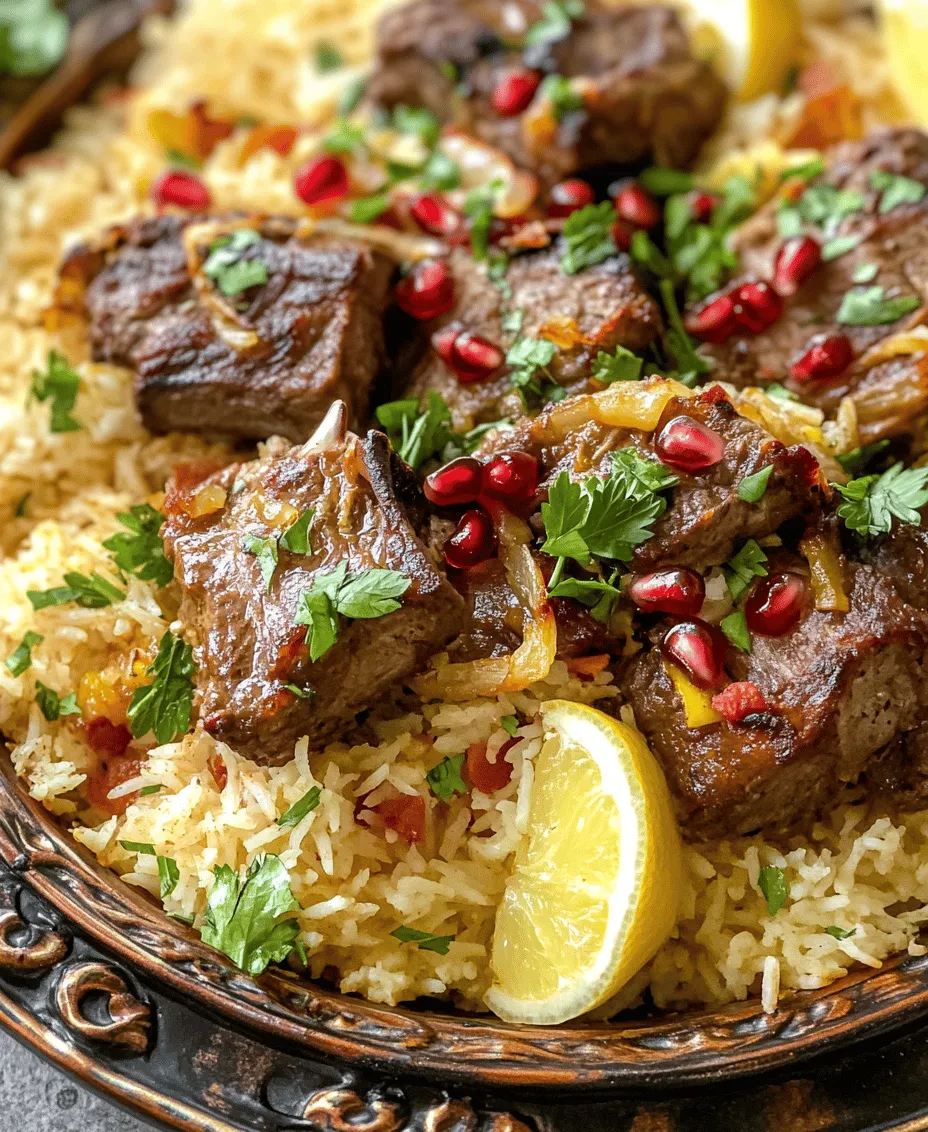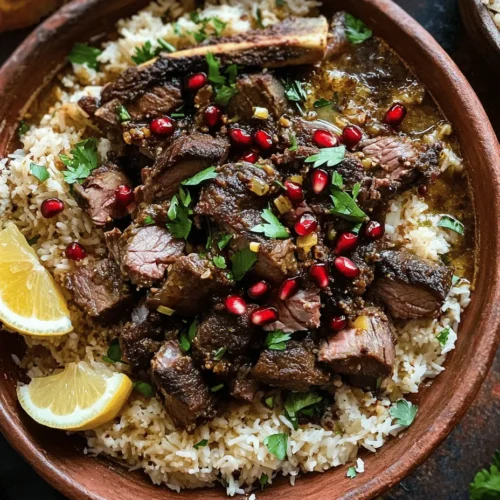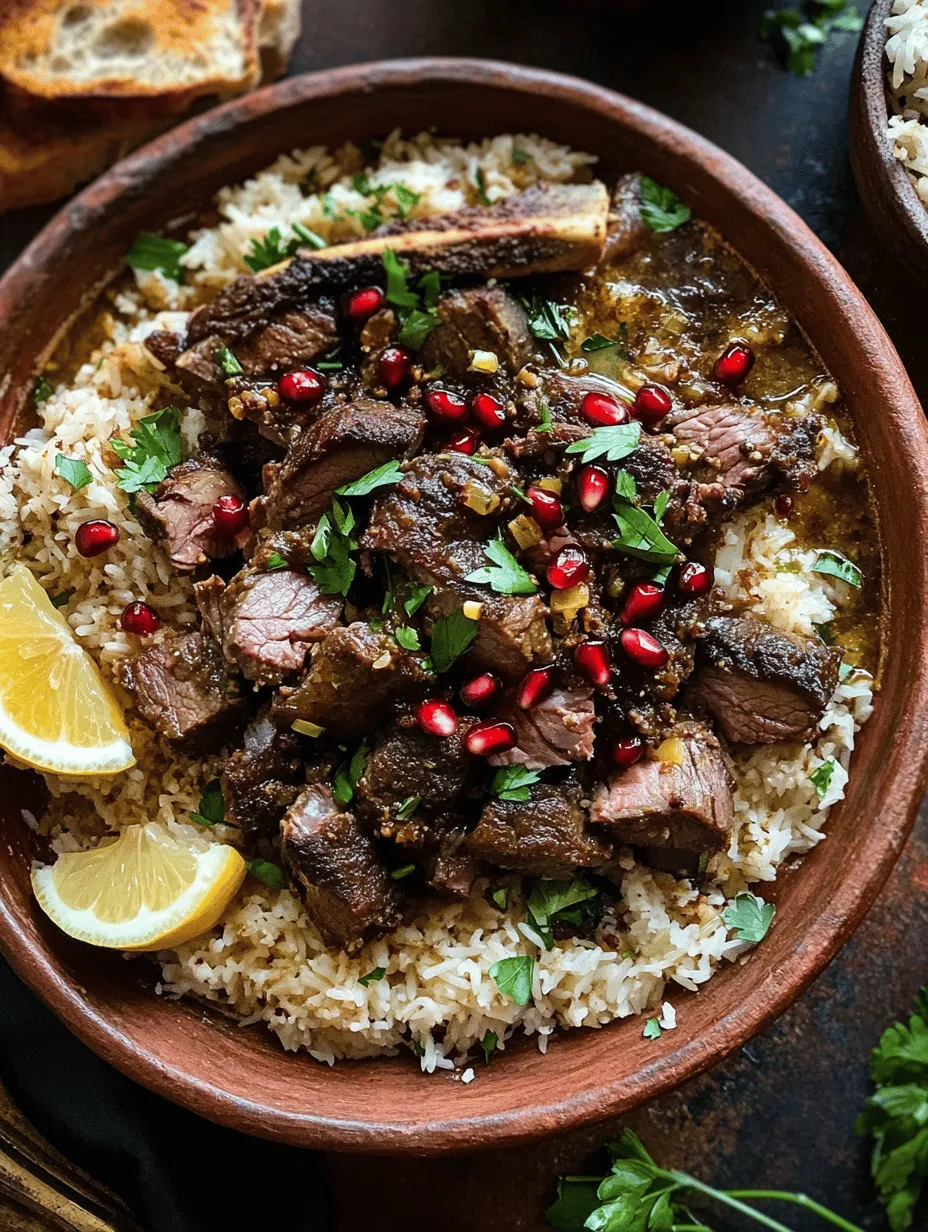Introduction
Fattah is a quintessential Egyptian dish that embodies the rich culinary heritage and vibrant culture of Egypt. Traditionally served during festive occasions, family gatherings, and significant celebrations such as Eid al-Adha, Fattah is more than just a meal; it’s a symbol of togetherness and hospitality. This beloved dish consists of layers of tender meat, aromatic rice, and flavorful sauces, all of which come together to create a hearty feast that is both satisfying and nourishing.
At its core, Fattah features a combination of tender lamb or beef, fluffy basmati rice, and a medley of spices that infuse the dish with an irresistible aroma and flavor. The communal nature of Fattah makes it a centerpiece at gatherings, where friends and family come together to share this delicious meal, reinforcing bonds and creating lasting memories.
In this article, we will delve into the ingredients, historical significance, and preparation techniques that make Fattah a standout dish in Egyptian cuisine. Whether you are a seasoned cook or a novice in the kitchen, this guide will provide you with everything you need to know to create an authentic Fattah Feast.
Understanding Fattah
The origins of Fattah trace back centuries and are deeply rooted in Egyptian history. This dish is believed to have evolved from ancient traditions, where layers of bread and meat were served as part of ceremonial feasts. The name “Fattah” itself is derived from the Arabic word for “to break,” which reflects the act of breaking bread and sharing food in a communal setting. Over time, Fattah has grown to symbolize generosity and the spirit of sharing, making it a staple at weddings, religious holidays, and family reunions.
Fattah varies across different regions in Egypt, with each area adding its own unique twist. For instance, in Cairo, Fattah may be served with a rich tomato sauce, while in Alexandria, a lemony garlic sauce is preferred. Despite these regional differences, the essence of Fattah remains the same: a delicious, hearty meal that brings people together.
At family gatherings, Fattah is often the star of the table, served on large platters for everyone to enjoy. The act of serving Fattah is a ritual in itself, as the layers of bread, rice, and meat are carefully arranged, showcasing the vibrant colors and textures of the dish. The communal aspect of sharing Fattah fosters a sense of unity and celebration, making it a cherished tradition in Egyptian culture.
Key Ingredients of Fattah Feast
To create an authentic Fattah Feast, understanding and selecting the right ingredients is essential. Here is a detailed overview of the primary components that define this iconic dish:
Lamb vs. Beef: Choosing the Right Meat
When it comes to the meat used in Fattah, both lamb and beef are popular choices, each offering distinct flavors and textures. Lamb is often favored for its rich taste and tenderness, particularly when sourced from younger animals. It brings a unique depth of flavor to the dish that pairs beautifully with the spices and rice.
On the other hand, beef is a more accessible option and can also yield delicious results. Choosing cuts such as chuck or brisket ensures a flavorful and tender meat that complements the other ingredients. Ultimately, the choice between lamb and beef depends on personal preference and availability.
The Importance of Basmati Rice
Basmati rice is the cornerstone of any Fattah Feast. Known for its long grains and aromatic qualities, basmati rice adds a delightful texture and subtle flavor to the dish. The cooking process is crucial to achieving the perfect fluffiness; each grain should remain separate, allowing it to soak up the rich flavors of the broth and spices.
Role of Spices
The magic of Fattah lies in its spices. A combination of cumin, coriander, paprika, and allspice creates a warm and inviting flavor profile that elevates the dish. These spices not only enhance the taste but also contribute to the rich aroma that fills the kitchen during cooking. The careful balance of spices is key to achieving the authentic flavor that characterizes traditional Fattah.
The Significance of Garlic and Onion
Garlic and onion play a pivotal role in creating a rich broth for Fattah. Both ingredients add depth and complexity to the flavor, serving as a base for the meat and spices. Sautéing garlic and onion until golden releases their natural sweetness and earthy notes, creating a savory foundation that enhances the overall dish.
Baladi Bread: Traditional vs. Modern Alternatives
Baladi bread, a type of Egyptian flatbread, is traditionally used as the base for Fattah. Its chewy texture and slightly sour flavor complement the layers of meat and rice, soaking up the delicious broth. While traditional Baladi bread is the preferred choice, modern alternatives such as pita or any other flatbread can be used in its place. The key is to ensure that the bread can hold up to the weight of the toppings while absorbing the flavors of the dish.
Chickpeas: Nutritional Benefits and Flavor Contributions
Chickpeas add both nutritional value and flavor to Fattah. Not only do they provide a source of protein and fiber, making the dish even more hearty, but their mild, nutty flavor pairs well with the spices and meat. Typically, chickpeas are added to the dish either cooked or as a garnish, providing a delightful contrast in texture.
Garnishes: The Visual Appeal of Parsley and Pomegranate Seeds
Finally, garnishes such as fresh parsley and pomegranate seeds bring a burst of color and freshness to Fattah. Chopped parsley adds a vibrant green contrast, while pomegranate seeds introduce a pop of sweetness and crunch. These garnishes not only enhance the visual appeal of the dish but also contribute additional layers of flavor, making Fattah a feast for the senses.
Preparing the Meat and Broth
To achieve a truly authentic Fattah, the preparation of the meat and broth is a crucial step that requires attention to detail. Here’s a step-by-step breakdown of how to prepare the lamb or beef for your Fattah Feast:
Importance of Simmering for Tenderness
The key to tender meat lies in the cooking method. Simmering the meat slowly allows the connective tissues to break down, resulting in a melt-in-your-mouth texture. Begin by cutting the meat into large chunks, which will ensure even cooking and tenderness.
Techniques for Skimming the Foam
As the meat simmers, it’s common for a foam to form on the surface of the broth. This foam is composed of impurities and proteins released during the cooking process. Skimming off this foam not only results in a clearer broth but also enhances the overall flavor of the dish. Use a ladle or a spoon to carefully remove the foam as it rises.
Infusing Flavors into the Broth
To create a richly flavored broth, add your chosen spices and aromatics to the pot. Begin with the sautéed garlic and onion, followed by the spices such as cumin, coriander, and allspice. Allow the spices to toast briefly before adding the meat and water, as this helps to release their essential oils and flavors.
How Long to Simmer for Optimal Taste
For optimal taste, the meat should be simmered for at least 1.5 to 2 hours, depending on the cut and size of the meat. During this time, check for doneness by testing the tenderness with a fork. The meat should be easily shred-able and infused with the flavors of the broth.
Tips on Seasoning to Personal Preference
Seasoning is a personal touch that can elevate your Fattah. After the meat has cooked, taste the broth and adjust the seasoning as needed. This is where you can add salt, pepper, or additional spices to cater to your taste preferences. Remember, the broth should be flavorful, as it will enhance the overall dish.
Cooking the Rice
The final component of Fattah is the rice, which should be fluffy and aromatic. Here’s how to achieve perfectly cooked basmati rice:
The Toasting Process: Why It Matters
Before cooking the rice, toasting it in a bit of oil or butter is an essential step. This not only adds a nutty flavor to the rice but also helps to seal the grains, preventing them from becoming mushy during cooking. Simply heat the oil in a pot, add the rinsed and drained basmati rice, and toast for a few minutes until the grains become slightly golden.
By understanding the ingredients, historical significance, and preparation techniques of Fattah, you can create an authentic Egyptian feast that honors tradition while delighting the palate. In the next part of this guide, we will explore the final steps of assembling and serving your Fattah Feast, ensuring that this culinary masterpiece is ready to impress your guests and create memorable moments around the table.

Managing Liquid Ratios and Cooking Times
When preparing the Fattah feast, precision in managing liquid ratios and cooking times is essential for achieving the perfect texture and flavor. The key to a successful Fattah lies in the balance between the broth and the bread. Generally, you want to aim for enough broth to soak the bread without making it overly soggy. A good starting point is to use roughly 2 to 3 cups of broth for every 4 cups of torn bread.
Cook the broth mixture until it reaches a gentle simmer before adding the bread. This will help the bread absorb the flavors without disintegrating completely. After incorporating the bread, allow it to soak for about 10 to 15 minutes while gently stirring to ensure even saturation. If you find the bread is too dry, you can always add a little more broth, but be careful not to overdo it.
Using broth instead of water significantly enhances the flavor profile of the dish. The rich undertones of chicken or beef broth not only infuse the bread with flavor but also complement the spices and toppings used in Fattah. Therefore, when preparing your broth, consider adding aromatics such as garlic, onion, and spices to deepen the taste further.
Preparing the Bread
Techniques for Toasting Egyptian Baladi Bread
Toasting Egyptian baladi bread is a crucial step in preparing Fattah. This bread is traditionally soft and slightly chewy, so toasting it properly will provide the necessary texture for the dish. To achieve the perfect toast, cut the bread into bite-sized pieces and spread them out evenly on a baking sheet. Preheat your oven to 350°F (175°C) and toast the bread for about 10-15 minutes, flipping halfway through to ensure even browning.
Alternatively, you can toast the bread on a stovetop using a skillet. Heat a little oil in the skillet over medium heat, then add the bread pieces. Keep an eye on them, turning frequently until they are golden and crispy.
The Ideal Oil Temperature for Perfect Crispiness
If you prefer to fry your bread for an even more decadent approach, the oil temperature is key. Heat your oil to around 350°F (175°C) before adding the bread. This high temperature will create a crispy outer layer while keeping the inside soft. Fry the bread pieces in batches, ensuring not to overcrowd the pan, which could lower the oil temperature and prevent proper frying. After frying, allow the bread to drain on paper towels to absorb excess oil, ensuring a lighter texture.
Assembling the Fattah
Layering Techniques for Presentation
Assembling the Fattah is as much about presentation as it is about flavor. Start by placing a layer of the soaked bread at the bottom of a large serving dish. Next, add a layer of the meat (if using) and chickpeas. For the best flavor absorption, it’s recommended to drizzle some of the broth over these layers before adding the next. This technique helps the flavors meld together beautifully.
Continue layering with a generous portion of garlic vinegar sauce, followed by a topping of fried onions for added crunch. The order of ingredients is crucial; by placing the bread at the bottom, it can soak up the flavorful broth, while the toppings provide a burst of flavor and texture at the top.
Importance of Soaking the Bread in Broth
Soaking the bread in broth is not just a functional step; it is a vital part of the dish’s flavor profile. Allowing the bread to soak in the seasoned broth for a sufficient amount of time enhances its flavor and helps meld it with the other components. This soaking process ensures that every bite of Fattah is infused with the rich, savory essence of the broth.
Incorporating Chickpeas for Added Texture and Nutrition
Chickpeas are often added to Fattah for both texture and nutrition. Their soft yet slightly firm consistency contrasts beautifully with the tender bread and crispy onions. Not only do chickpeas provide a hearty element to the dish, but they are also an excellent source of protein and fiber, making Fattah a well-rounded meal. When layering, sprinkle chickpeas generously to ensure they are distributed evenly throughout the dish.
Garnishing and Serving Suggestions
Creative Ideas for Presentation
Presentation can elevate the dining experience, making your Fattah feast visually appealing. Consider serving the dish in a large, shallow platter that showcases the vibrant colors of the ingredients. Garnish with fresh herbs like parsley or cilantro, which add a pop of color and freshness. You can also add a sprinkle of paprika or sumac for an extra layer of flavor and visual interest.
Arrangement of Garnishes for Visual Appeal
When garnishing, think about how different colors and textures can complement each other. A sprinkle of toasted pine nuts or slivered almonds can add a lovely crunch, while a drizzle of tahini sauce offers a creamy contrast. Arrange your garnishes in a way that highlights the various layers of the dish, making it inviting for guests.
Alternative Garnishes: Exploring Regional Variations
Fattah is a versatile dish, and regional variations can introduce exciting new elements. For instance, in some areas, you might find it garnished with a dollop of yogurt or a tangy lemon sauce. Experiment with different toppings based on what’s locally available or to suit your taste preferences.
Serving Tips: Best Practices for Sharing Fattah in a Communal Setting
Fattah is often served in a communal setting, making it a perfect dish for family gatherings or celebrations. Serve it directly from the platter, allowing guests to help themselves. Provide large spoons for serving and ensure there are enough plates for everyone. Encourage sharing and passing around the dish, which fosters connection and conversation among diners.
Cultural Significance of Fattah
The Role of Fattah in Egyptian Holidays and Special Occasions
Fattah holds a special place in Egyptian culture, often associated with significant holidays and celebrations. It is traditionally served during Eid al-Adha, where families gather to celebrate and share meals together. The dish symbolizes abundance and togetherness, making it a staple during festive occasions.
Personal Anecdotes or Stories Related to Fattah in Egyptian Families
Many Egyptian families have their own unique stories and traditions surrounding Fattah. For instance, some may recall fond memories of their grandparents preparing the dish for large family gatherings, where the whole family would come together to enjoy the feast. These personal anecdotes not only enrich the cultural significance of Fattah but also illustrate the love and care that goes into preparing this cherished meal.
How Fattah Fosters Community and Connection During Meals
Sharing a meal like Fattah goes beyond just sustenance; it fosters community and connection. The act of gathering around a shared dish encourages conversation and bonding among family and friends. In Egyptian culture, meals are often seen as an opportunity to connect, making Fattah a perfect centerpiece for family gatherings.
Nutritional Analysis of Fattah
Breakdown of Nutritional Components in Fattah
Fattah is not only delicious but also nutritious. The main components—bread, meat, chickpeas, and broth—provide a balanced mix of carbohydrates, proteins, and essential vitamins. The chickpeas contribute significant amounts of fiber, helping with digestion and overall health.
Health Benefits of Using Fresh Ingredients and Whole Foods
Using fresh, whole ingredients in Fattah not only enhances the dish’s flavor but also boosts its nutritional value. Fresh vegetables, herbs, and quality meats make for a more wholesome meal, supporting a healthy diet. Additionally, making your broth from scratch allows you to control the sodium content and avoid preservatives often found in store-bought options.
Considerations for Dietary Modifications (e.g., Vegetarian Options)
For those looking to enjoy Fattah while adhering to vegetarian or vegan diets, modifications can easily be made. Substitute the meat with roasted vegetables or a hearty lentil mixture. Using vegetable broth will maintain the flavor while accommodating different dietary needs without sacrificing the essence of the dish.
Conclusion
In summary, Fattah is more than just a recipe; it represents a rich tapestry of Egyptian culture and tradition. From its careful preparation to the communal experience of sharing a meal, every aspect of Fattah speaks to the heart of Egyptian hospitality and family values.
As you explore this delicious dish, consider the joy it brings to your table and the connections it fosters with family and friends. Whether you’re celebrating a holiday or simply enjoying a cozy meal at home, try preparing Fattah and share it with those you love. Embrace the art of cooking and the communal experience of enjoying a traditional meal, and you’ll find that Fattah is not just food—it’s a celebration of life.



